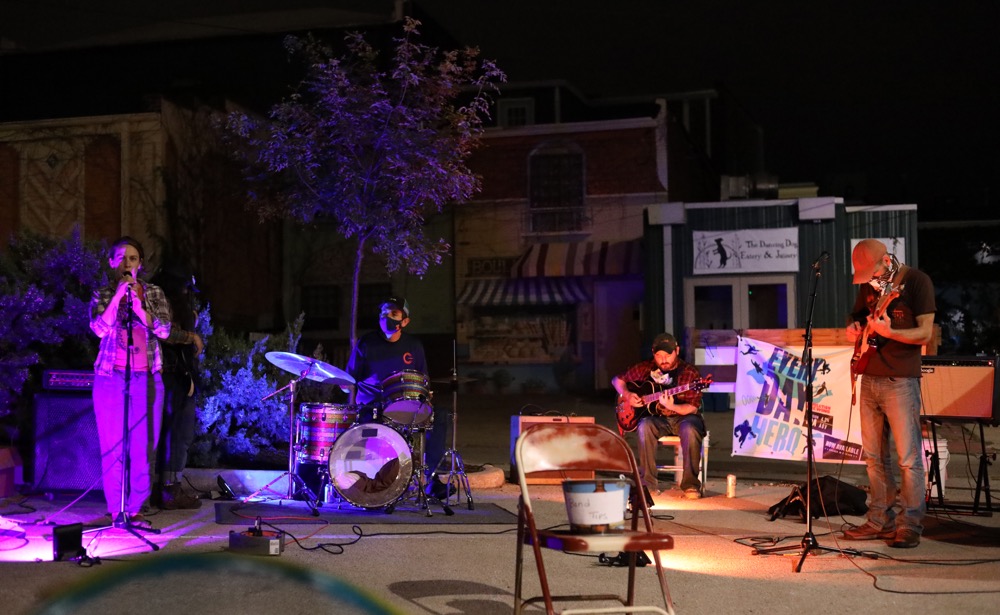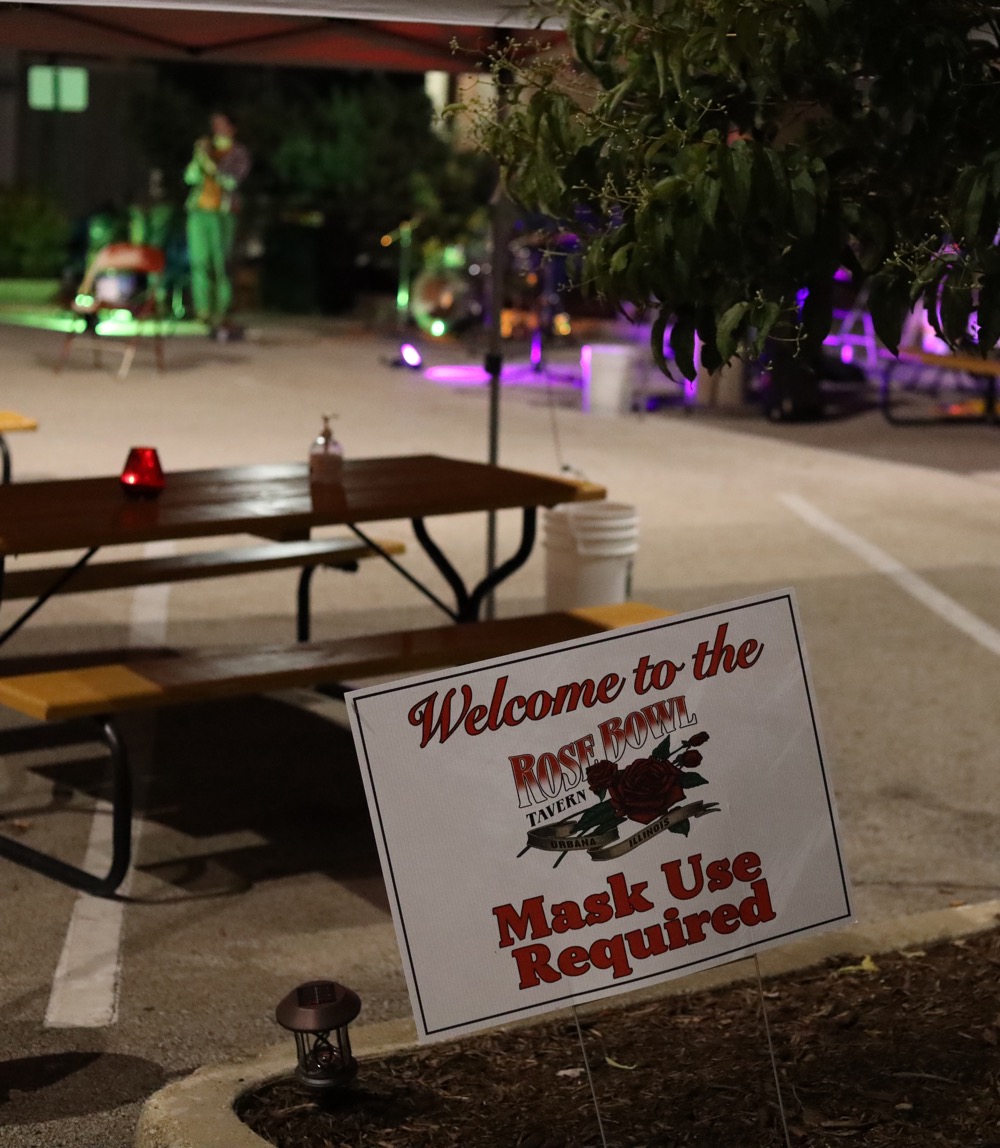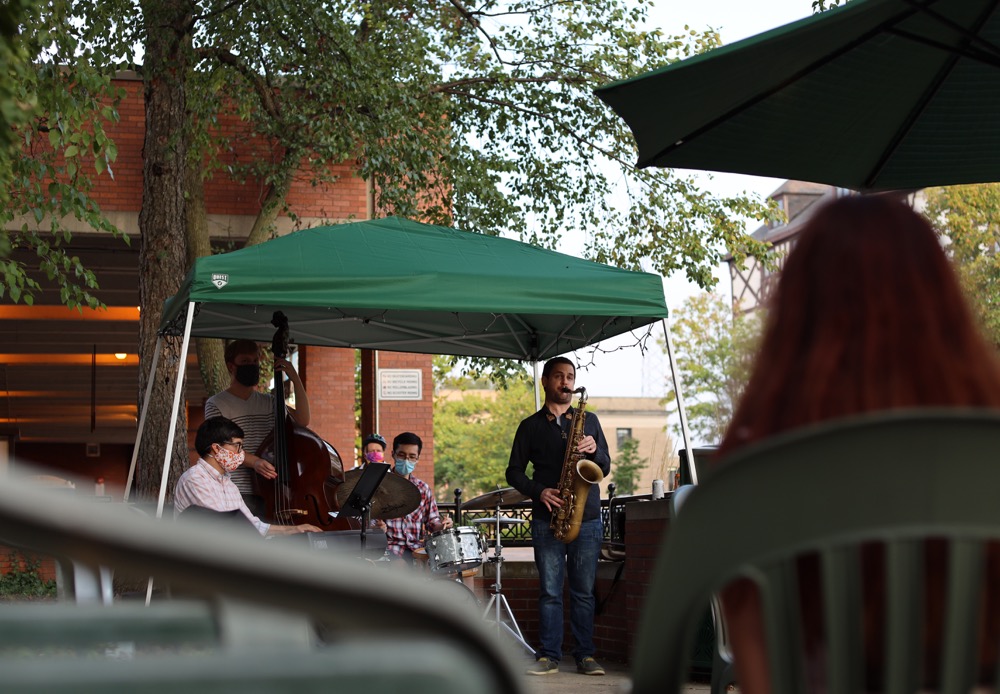On a mild evening this weekend, as summer began giving way to fall, downtown Urbana was saturated with the sound of live music. At 5:30 p.m. on Friday, I parked in the Busey Bank lot on Race Street and walked across to the patio beside the Iron Post. It took a minute to get a seat. The long rectangular space was set up with seating for perhaps 25 people, widely spaced, most of which was taken. After a minute I settled in to catch a few tunes of a jazz quartet led by Joe Longardner. Walking down the alley by the parking structure at the set break I heard part of another jazz set, this one led by saxophonist Brad Wheeler, at NOLA’s Rock Bar. A bit later I rambled a block down Race to the Rose Bowl to hear a set by The Merry Travelers, featuring singer-songwriter Holly Curia, in a space the bar has set up in the parking lot, again with widely distributed tables.
After months of strictly limited public activity and lots of streamed media events, it was a more deeper pleasure than I could have anticipated to sit in the cool air and hear local bands in the company — the physically distanced, but somehow socially close company — of fellow Chambanites.
Phase 4, guidelines to follow, businesses work to make it possible
It was a long spring and summer for local bars and restaurants. It’s been a long spring and summer for so many in our community, as safety protocols have dictated the need to limit activity. Live music has been particularly hard to stage safely, because of its connection to other unsafe activities — drinking, dancing, and general revelry. Singing, especially, and playing saxophones, trumpets, and other wind instruments, pose inherent risks with a virus spread through breath. Studies conducted at the University of Colorado and University of Maryland indicated outdoor music-making as a key way to mitigate risk from these activities.
Musicians, venue owners, and patrons alike expressed concern about safety. I spoke with drummer and multi-instrumentalist Cody Jensen who was playing with The Merry Travelers. “I’ve passed up a lot of bookings,” he said. “Out of town gigs, where I just didn’t trust that they’d handle things safely.” He was concerned for his and his fellow musicians’ health, but also for the larger community. “Even if the stage is set apart, you don’t want to be part of something that might spread the virus.”
The Cities of Urbana and Champaign both follow the state’s Phase 4 guidelines, which require distance between musicians and audience, and require audiences to remain seated at all times. Urbana has instituted a series of more specific guidelines since live music became legal again in June, including limits on late performance (9 p.m. on weeknights, 10 p.m. on weekends), a minimum of 10 feet between performers and audience, and guidance that performers should wear face coverings whenever possible.
Rose Bowl co-owner, Marten Stromberg, described safety as a key concern for the venue, “even beyond the guidelines.” He noted that “for a lot of people, the first time going out since the pandemic began is at the Rose Bowl. We want people to be able to feel comfortable coming out because we’re doing it safely.”
Saxophonist Joe Longardner noted how impressed he was with Iron Post owner Paul Wirth’s precautions, which include fans to clear out aerosolized particles, along with distance, hand sanitizer, and a mask policy. It not only allows the business to continue, but gives jazz musicians in the community — many of whom are also U of I students — the chance to “keep practicing our craft, while taking the necessary actions to keep everyone safe and healthy.”
I’m a musicologist, not an epidemiologist or a public health official, but I can say I was impressed with what I saw at all these venues. People maintained distance, everything was outdoors, where aerosolized particles are likely to dissipate rapidly, people seemed conscientious about mask use, and hand sanitizer was in ample supply.

Hobnob String Band at the Rose Bowl featuring, L to R, Holly Curia (vocals), Charlie Harris (bass), Dave Pride (drums), Falbo (guitar), Sam Payne (guitar). Photo by Gabriel Solis.
Live and Live streaming
The Rose Bowl, in particular, has invested significantly in live streaming for music, hosting a series of shows online throughout the lockdown, and continuing to run a regular “Folkin’ Tuesday” series with the band Chicago Farmer. Like live streams from larger venues with more famous artists, these shows have kept musicians active, entertained audiences, and given the industry a way to make up some lost income.
For me, though, and for musicians and patrons at shows I spoke with, live music is the thing. In my research as a musicologist I’ve studied the ways music can produce a feeling of “communitas,” of being connected — for better, and sometimes for worse. Never has this been clearer to me than now, when being together, literally, has been unsafe. It is a relief to me to hear music in the open air, under blue skies and under stars, with the low hum of other tables’ chatter audible between songs.
I’ve played my share of gigs with small and distant audiences, even without the pandemic, and I know it can make for an odd dynamic. I was interested to hear from all the musicians I talked with that it had seemed difficult at first, but after a bit more than a month of regular playing they and their audiences have gotten more used to the physical distance and adapted to it. I’d say the atmosphere is a bit less intense than at plenty of indoor shows I’ve been to, but at least for me, at least right now, that feels like a good thing.
The economics of live music for artists, venue owners, and the community
Live music is not just a pleasure, it is also a key element in a surprisingly large sector of the economy — nationwide and in C-U. The shutdown of live events has been devastating for artists and venue owners alike, and continues to be a concern. C-U continues to miss larger-scale, national touring acts, and will for the foreseeable future. But for a number of local gigging musicians as well as for the venues that are offering this entertainment, the return of live music has been an important shot in the arm.
Nothing summed up the “new normal” like bassist Charlie Harris’s announcement at the end of a set. “There’s a tip bucket up here. At the break I’ll put my mask on and bring it around so you don’t have to get up from your table.”
I admit I found myself more compelled than ever to pay.

Signage at the Rose Bowl Tavern. Photo by Gabriel Solis.
Get out and hear this music now, while the weather’s still good for it
Our towns will be filled with live music for at least another month or two, while the weather is still mild. Urbana venues with outdoor music include The Rose Bowl, The Iron Post, NOLA, and Boomerang’s; Champaign venues include Pour Brothers, The City Center, and Clark Bar.
Safety remains a crucial concern, so if you’re going out, mask up, wash hands, sit in small groups, and keep your distance. And don’t forget to tip.








